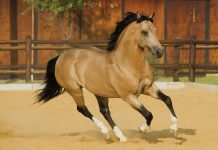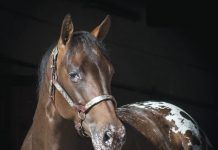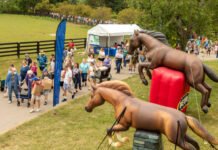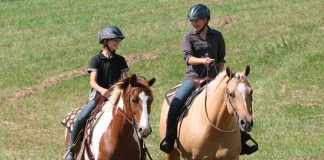It happens to everyone once in a while. You ask your horse to canter and off he goes — on the wrong lead! His outside foreleg reaches out farther than his inside foreleg, and his canter feels unbalanced. If you’re lucky, your horse has no problems picking up the correct lead. But if the Young Rider “Help” letters are anything to go by, quite a few of you are having trouble getting your horses on the right lead. So let’s take a look at the canter, and figure out the best way to make sure your horse takes off on the right lead the first time you ask.
Start Off Right
Asking for the Canter
If you’re having problems getting the correct lead, always ask for the canter in a corner, or while you are trotting in a circle. Here are the correct signals to tell your horse to canter:
- Put your inside leg (the one next to the middle of the arena) near the girth.
- Put your outside leg (the one closest to the arena fence) behind the girth.
- Squeeze with the inside rein so your horse turns in his head slightly. You should be able to see his eyeball before you actually give him the signal to canter.
- Finally, give him a kick with your outside leg (the one behind the girth), Correct Lead?
If your horse is on the correct lead his inside foreleg will reach out ahead of his outside foreleg. If you’re traveling to the right, your horse is on the “right lead.” If you’re traveling to the left, your horse is on the “left lead.”If you’re on the correct lead, your horse will feel smooth at the canter. If he’s on the wrong lead, he may feel bumpy and awkward. If you can’t tell just by “feeling” if your horse is on the correct lead, you’ll need to glance down and look at his inside leg to see if it stretches out farther than his outside leg. Don’t lean forward and look down though, because you’ll unbalance your horse and he might start trotting again. Simply glance down with your eyes — not your whole body!
Wrong Lead? Try Again Quickly!
If you’re on the incorrect lead, your horse’s outside foreleg will stretch out farther than his inside leg. If you’re on the wrong lead, bring your horse back to a trot immediately. If you’re near a corner of the arena, squeeze on the inside rein and ask for the canter again. If you aren’t near a corner do a 20-meter circle so your horse is bending his body and ask for the correct lead. Once he takes it, leave the circle and go large around the arena again. Give him a pat to let him know that he’s done the correct thing.Wrong Lead Again?
If your horse seems to be landing on the wrong lead a lot, try cantering him on a lunge line. If he picks up the correct lead with no problem, the problem is probably the rider on his back — um, that’s you! Sometimes a floppy rider can unbalance a horse, and he’ll find it difficult to take off on the correct lead. Or you might not be asking him properly. If you just can’t seem to get the correct lead, it might be time to have lessons with an instructor. She might be able to give you some pointers that can help you work with your horse better.Sometimes this little trick works: As you head into a corner, squeeze on the outside rein and ask your pony to turn his head to the outside, then squeeze on the inside rein to make him turn his head to the inside. Just as he’s turning his head, ask him to canter with your leg aids. This method isn’t pretty but it can be effective. Turning his head out, then in, unbalances him slightly, and as he turns to the inside he’ll tend to take off with the inside leg leading. Do this exercise until he gets the lead every time, then go back to the correct way of asking for the lead.
Advanced Tip
As you trot, pay attention to your horse’s footfalls-the order in which his hooves hit the ground. If you watch a horse from the ground, his diagonal pairs of legs move together. The front right leg and the rear left leg move forward together and the front left leg and the rear right leg move together.
When you are trotting, glance down at the outside foreleg. When it is heading back under your horse, ask for the canter. Why? When the outside fore is coming down, his outside hind leg is just about to push off underneath of him; this is the leg that influences how your horse departs in the canter.
So, glance down. When the outside fore is under your horse, nudge him with your outside leg to ask for the canter.





